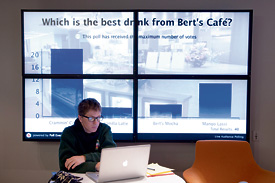Digital Signage Service
• Shared software and support
• Cost savings
• Emergency alert and other shared messaging
• Groups within the Medical School, Hospitals and Health Centers and other parts of the U-M Health System interested in digital signs should contact [email protected].
Walking into the Shapiro Library, students are confronted with a question posted on a large video wall: Which of your classes is the hardest? Within seconds their responses relayed via text message are posted on four large-screen television monitors arranged in one large rectangle. Other nearby video walls display student artwork and an announcement about an event across campus.
During the summer art fairs, a tornado warning was issued on the weekend and similar signs in the School of Social Work automatically reflected the emergency, even before sirens sounded. Art fair attendees near the entrance of the building took note of the message, alerted others in the area and a number of people were able to take shelter. While the tornado moved though an area south of the city, the signs proved valuable as one more means to alert the public to potential danger.
The library and SSW are among a growing number of units across campus using digital signs as a way to communicate and engage with the community. And now schools, colleges and departments are able to unite under one system, use the same software and receive support through a service developed with leadership by the university’s IT Council.
Information and Technology Services launched the new Digital Signage Service on Nov. 30. It is available to all administrative and academic units on the Ann Arbor campus as well as the U-M Health System. The service is available to the Dearborn and Flint campuses on a pilot basis.
“A centralized service is vital in keeping the costs for the service low. It allows a centralized group to do research on costs and functionality that would otherwise need to be handled by each individual unit. In addition, costs for the service, support and licenses can be distributed across participating units,” says Christopher Gardner, SSW Computing and Technology Services Help Desk supervisor, who serves as the technical lead for units that adopt the system.


Quinn Kane studies in front of an interactive video wall in Bert’s Café in the Shapiro Library. The wall allows staff to pose questions that can be answered instantly. The School of Public Health offers students some hints on how to avoid stress during busy exam time. SPH uses digital signs to promote events, share accolades and offer public health messages such as this one for faculty, staff and students. Photo by Scott Soderberg, U-M Photo Services.
Photo courtesy School of Public Health.
“Other benefits include shared resources between units, especially with emergency messaging capabilities that have been developed with the Department of Public Safety. This is important, as the digital signs provide information to people that the e-mail and phone alerts are unable to reach, such as visitors and sporting event attendees. In addition, correctly configured signs will relay emergency warnings in less than a minute.”
There currently are more than 30 units with 200 signs in the system and many more are expected to go online in the near future at UMHS, the North Campus Research Center and a number of other locations. Units are using them to post websites, tweet information, share photos, announce events, and post schedules, maps, weather and bus routes.
At the Health System, digital signs already inform hospital cafeteria customers of upcoming events and featured foods, and are being used at several health centers.
In the Shapiro Library, a team meets every week to plan fresh content to use in Bert’s Study Lounge to engage students, says Jamie Vander Broek, digital learning services librarian.
“People have an idea about a library as a place to keep books and study. This technology gives us a chance to get students engaged in a bigger conversation and move it forward in that way,” Vander Broek says. She also notes that having virtual exhibits in the places students gather not only offers better exposure for collections and services but also allows the library to showcase more works.
Plans for Bert’s came through focus groups in which students said they wanted the ability to gather around a table, plug their laptops into a display screen to work collaboratively, and also have a venue to share their projects with their peers. The student-driven, on-demand use of the display walls is the result.
Support for the new service is being shared by ITS and a newly established Community Governance Board, acting as the business owner.
The digital signage project was spearheaded by Lynn Johnson, professor of dentistry and assistant dean of informatics and innovation, School of Dentistry, technical adviser to the provost and executive vice president for academic affairs, and clinical professor of information, School of Information. The School of Dentistry was among the first to install digital signs to post announcements and help patients and visitors with wayfinding. In addition to the advantages for those currently using the system, Johnson sees great possibilities for the future of the technology.
“Using the signs I can now find out where the bus is. It would also be good to know which library on campus has the book I need and what the score of the basketball game is. Only a shared service makes all this possible,” Johnson says.
“Dan Atkins, vice president for cyberinfrastructure and chair of the IT Council, describes the technology pillars of leaders as connected, mobile, collaborative/social, and big data. A collaborative signage service can be all of them,” Johnson adds.
“In our vision for the future of this technology, the signs all would be connected allowing messages to be connected — or networked — yet still conveying unit specific content. We hope that one day the signs will sync with our mobile devices. We’ll build on the social networking capabilities through blogs and tweets and take advantage of data that resides in numerous online systems across the university and beyond.”
In addition to hand-held synchronization that is being developed by the software company Four Winds Interactive, Gardner says other enhancements for the future include blind-user assistance for those with visual difficulties, advanced wayfinding, collaborative advertising and more advanced emergency messaging. The service board hopes one day to be able to support a content manager to offer shared news and information, and campuswide events.
At present, each unit pays the expense of purchasing and supporting the hardware — which includes monitor, computer and the case that houses the sign — and creating content. A new fee structure calls for a service fee of $100 per monitor for fiscal year 2012, which will increase to $350 in 2013. The cost for the service will be reviewed annually. Pricing information is posted at www.itd.umich.edu/digital-signage/pricing.php.

